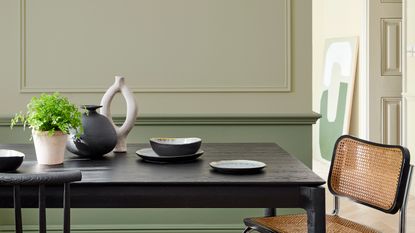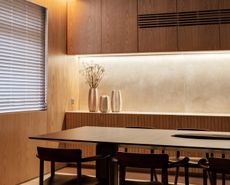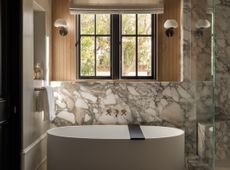Interior designers share their secrets to curating one of the biggest trends of the year - biophilic colors
Decorating with biophilic color is one of this year's hottest interior design trends; use these expert tips to incorporate it into your home


Decorating your home with biophilic color is a path to much-needed serenity and joy. It's no coincidence that biophilic design is fast becoming one of the biggest interior design trends.
As we spend more and more time at home, working and resting, feeling closer to nature feels essential rather than a 'nice to have'. Not everyone is able to remodel their home to let in more natural light or create a link with a garden if they don't have one.
However, biophilic color is available to everyone and is the easiest way to enhance a home's connection with nature. We've asked interior designers and paint experts to explain how to incorporate biophilia into your color choices.

Wall in Clay Mid 153 in Absolute Matt Emulsion £48.50 for 2.5L, LIttle Greene
1. Curate a color palette from your favorite landscapes

Using biophilic color at home is all about using a palette rather than just an accent wall. It's interior design's version of mimicry, but which landscape you choose to reproduce is entirely up to you.
Claire Gaudion, artisan textile designer and biophilic design specialist, says 'My top tip is to notice the tones of colors around you when you are out in nature and notice how they make you feel. When you have identified the right tonal pitch for you, the colors which trigger the right emotions for you, nature gives you the colors in the right proportions for use in the home.'
Choosing the right biophilic color pattern for you is all about choosing the colors that soothe and inspire you, personally.
'Are you uplifted by the greens and whites of hedgerows in Spring?' Claire says. 'Or drawn to the rich, warm apricots and blue hues of a sunrise over the ocean? Or do you feel most relaxed amongst the quiet tones of dappled skies and shadows in a late summer meadow? Choose the tones that work for you, according to how you wish to feel.'
2. Explore green and wood combinations

Veronese Green, Benjamin Moore
To enhance the mimicry effect of your biophilic color palette, you may choose to go one step further and pair the natural colors of wood with green shades that remind you of forests. Or do you associate green more with the color of the sea? In that case, you could pair green with natural stone or sandy colors.
Ruth Mottershead, Creative Director of Little Greene, praises green's versatility. 'Green combines harmoniously with plenty of neutral tones or layers of other greens,' she says.
'We are very comfortable with this combination because we are used to seeing so much of it in the natural environment. Green combines fabulously with earthy tones, wood finishes of every kind, along with paler shades like creams and stone, and darker, richer colors such as browns and blacks.'
You can be playful with green shades, too – if you observe green in nature, it's rarely a uniform shade. Explore the best green paint in our guide to choose green shades that inspire you.
3. Don't shy away from using different tones

Wall, Mazarine Absolute Matt Emulsion £48.50 for 2.5L, Little Greene
Shade layering is the main difference between biophilic color use and other color trends such as color blocking. Beyond paint wall ideas, biophilc design is all about different elements in a room coming together to reproduce the peaceful feeling of a landscape.
If you're going for a marine theme, for example, consider using several different shades of blue to create a harmonious look that's never flat. Natural landscapes are not static but in constant flux, and you want to bring some of that mutability to your color choices.
Be The First To Know
The Livingetc newsletter is your shortcut to the now and the next in home design. Subscribe today to receive a stunning free 200-page book of the best homes from around the world.

Anna is a professional writer with many years' experience. She has special interests in architecture, photography, and high-end interior design. Her work has appeared in Homes & Gardens, Gardeningetc, and many other publications.
-
 How Can I Hide the Lights Under My Kitchen Cabinets? 4 Effective Ways to Conceal Wires
How Can I Hide the Lights Under My Kitchen Cabinets? 4 Effective Ways to Conceal WiresWhile undercabinet lights are super practical, they have a small downside — their visible network of wires can spoil the look of the room. Experts tell us how to hide this eyesore
By Aditi Sharma Maheshwari Published
-
 5 Things People With Flattering Bathrooms Never Have — (And You Shouldn't Either!)
5 Things People With Flattering Bathrooms Never Have — (And You Shouldn't Either!)Designers say you should avoid these five things if you want a bathroom that flatters your reflection and therefore uplifts your mood
By Oonagh Turner Published

